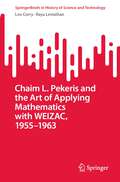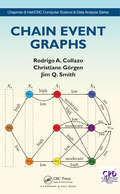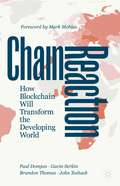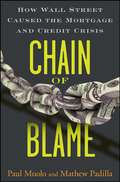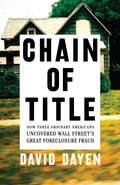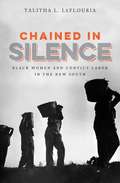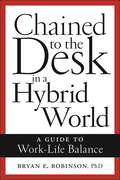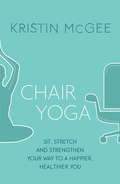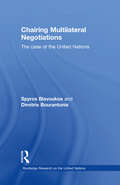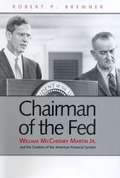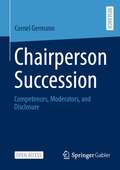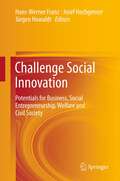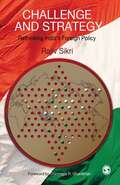- Table View
- List View
Chad-Cameroon Petroleum Development and Pipeline Project (C)
by Aldo Sesia Benjamin C. EstySupplements the (A) case.
Chad-Cameroon Petroleum Development and Pipeline Project (C) (Abridged)
by Aldo Sesia Benjamin C. EstySupplements the (A) case.
Chad-Cameroon Petroleum Development and Pipeline Project (D)
by Aldo Sesia Benjamin C. EstySupplements the (A) case.
Chadwick, Inc.: The Balanced Scorecard
by Robert S. KaplanThe pharmaceutical division of a diversified company has been asked to develop a Balanced Scorecard. Research and development projects take about ten years to bring a new product to the marketplace and the division depends on good relations and active feedback from its customers for continued success. But currently, the division is evaluated by meeting monthly financial objectives. The case describes an early and less-than-successful attempt to develop a Balanced Scorecard encompassing financial, customer, internal process, and innovation perspectives.
Chadwick, Inc.: The Balanced Scorecard (Abridged)
by Robert S. KaplanThe pharmaceutical division of a diversified company has been asked to develop a Balanced Scorecard. Research and development projects take about ten years to bring a new product to the marketplace and the division depends on good relations and active feedback from its customers for continued success. But currently, the division is evaluated by meeting monthly financial objectives. This case describes an early and less-than-successful attempt to develop a Balanced Scorecard encompassing financial, customer, internal process, and innovation perspectives.
Chai Point: Disrupting Chai
by Rachna Tahilyani Shikhar Ghosh Ramana NandaChai Point is India's largest organized chai retailer. It has missed its target for retail store openings by approximately 25%, goals that are very important to its investors who are also their board members. However, it has developed an exciting new Internet based tea dispenser, that has the potential to dramatically increase Chai Point's market opportunity and growth rate but can be seen as a change in their growth strategy. The founder needs to decide his strategy for his next board meeting. Should he focus on their past performance? Or should he spend time outlining boxC.in's technology and potential, since this will be the first time that the institutional investors will be seeing this new capability?
Chaim L. Pekeris and the Art of Applying Mathematics with WEIZAC, 1955–1963 (SpringerBriefs in History of Science and Technology)
by Leo Corry Raya LeviathanThis book describes the groundbreaking work of Chaim Leib Pekeris and his collaborators. Between 1955 and 1963 they used the first electronic computer built in Israel, the Weizmann Automatic Computer (WEIZAC), to develop powerful numerical methods that helped achieve new and accurate solutions of the Boltzmann equation, calculate energy levels of the helium atom, produce detailed geophysical and seismological models derived from the study of the free oscillations of the earth, and refine models used to predict meteorological phenomena and global oceanic tides. This book provides a unique account of the pioneering work of Chaim L. Pekeris in applied mathematics and explains in detail the background to the rise of the Weizmann Institute as a world-class center of scientific excellence. This hitherto untold story is of great interest to historians of twentieth-century science with special emphasis on the application of computer-assisted numerical methods in various branches of mathematical physics.
Chain Event Graphs (Chapman & Hall/CRC Computer Science & Data Analysis)
by Rodrigo A. Collazo Christiane Goergen Jim Q. SmithWritten by some major contributors to the development of this class of graphical models, Chain Event Graphs introduces a viable and straightforward new tool for statistical inference, model selection and learning techniques. The book extends established technologies used in the study of discrete Bayesian Networks so that they apply in a much more general setting As the first book on Chain Event Graphs, this monograph is expected to become a landmark work on the use of event trees and coloured probability trees in statistics, and to lead to the increased use of such tree models to describe hypotheses about how events might unfold. <P><P>Features: <P><P>introduces a new and exciting discrete graphical model based on an event tree <P><P>focusses on illustrating inferential techniques, making its methodology accessible to a very broad audience and, most importantly, to practitioners <P><P>illustrated by a wide range of examples, encompassing important present and future applications <P><P>includes exercises to test comprehension and can easily be used as a course book <P><P>introduces relevant software packages <P><P> Rodrigo A. Collazo is a methodological and computational statistician based at the Naval Systems Analysis Centre (CASNAV) in Rio de Janeiro, Brazil. Christiane Görgen is a mathematical statistician at the Max Planck Institute for Mathematics in the Sciences, Leipzig, Germany. Jim Q. Smith is a professor of statistics at the University of Warwick, UK. He has published widely in the field of statistics, AI, and decision analysis and has written two other books, most recently Bayesian Decision Analysis: Principles and Practice (Cambridge University Press 2010).
Chain Reaction: How Blockchain Will Transform the Developing World
by Gavin Serkin Paul Domjan Brandon Thomas John ToshackAmidst the constant stream of overly technical and excitable books heralding a blockchain revolution that’s destined to be more disruptive than the Internet, this book stands apart for its more nuanced take, focusing on the potential for these new technologies to change developing countries for the better. Chain Reaction divides the world into two: for some, blockchain seems a poor substitute for an efficient banking and regulatory system in which transactions are settled instantly and contracts are underpinned by solid institutions. For others, it will be truly life-changing – namely those living in countries where rule of law is weak, concepts of ownership are vague and, consequently, trust in institutions is in scarce supply.With blockchain, we are about to witness a leapfrogging – one that will bring the next billion emerging consumers into the formal economy by creating reliable institutions of contract, ownership and trust among people previously denied such luxuries. The authors humanize the technology by taking the reader on a global journey through a multitude of applications – from registering property to voting and delivering aid. In place of the usual abstract lessons in complex technology, this book is instead filled with lively anecdotes of places where trust is so weak that a crisp dollar bill sells at a premium to a better-used version. The book’s goal is to create the first truly approachable, entirely comprehensible and enjoyable read on the wonders to come from blockchain.
Chain Saw Industry in 1974
by Michael E. PorterDescribes the structure of the chain saw industry in 1974, when it is on the threshold of a major period of growth. Data are provided on each significant competitor. The discussion should center around strategies in a growing market for differently situated competitors.
Chain of Blame
by Paul Muolo Mathew PadillaAn updated and revised look at the truth behind America's housing and mortgage bubblesIn the summer of 2007, the subprime empire that Wall Street had built all came crashing down. On average, fifty lenders a month were going bust-and the people responsible for the crisis included not just unregulated loan brokers and con artists, but also investment bankers and home loan institutions traditionally perceived as completely trustworthy.Chain of Blame chronicles this incredible disaster, with a specific focus on the players who participated in such a fundamentally flawed fiasco. In it, authors Paul Muolo and Mathew Padilla reveal the truth behind how this crisis occurred, including what individuals and institutions were doing during this critical time, and who is ultimately responsible for what happened.Discusses the latest revelations in the housing and mortgage crisis, including the SEC's charging of Angelo Mozilo Two well-regarded financial journalists familiar with the events that have taken place chronicle the crisis in detail, showing what happened as well as what lies aheadDiscusses how the world's largest investment banks, homeowners, lenders, credit rating agencies, underwriters, and investors all became entangled in the subprime messIntriguing and informative, Chain of Blame is a compelling story of greed and avarice, one in which many are responsible, but few are willing to admit their mistakes.
Chain of Title: How Three Ordinary Americans Uncovered Wall Street's Great Foreclosure Fraud
by David DayenIn the depths of the Great Recession, a cancer nurse, a car dealership worker, and an insurance fraud specialist helped uncover the largest consumer crime in American history-a scandal that implicated dozens of major executives on Wall Street. They called it foreclosure fraud: millions of families were kicked out of their homes based on false evidence by mortgage companies that had no legal right to foreclose.Lisa Epstein, Michael Redman, and Lynn Szymoniak did not work in government or law enforcement. They had no history of anticorporate activism. Instead they were all foreclosure victims, and while struggling with their shame and isolation they committed a revolutionary act: closely reading their mortgage documents, discovering the deceit behind them, and building a movement to expose it.Fiscal Times columnist David Dayen recounts how these ordinary Floridians challenged the most powerful institutions in America armed only with the truth-and for a brief moment they brought the corrupt financial industry to its knees.
Chained in Silence: Black Women and Convict Labor in the New South
by Talitha L. LeflouriaIn 1868, the state of Georgia began to make its rapidly growing population of prisoners available for hire. The resulting convict leasing system ensnared not only men but also African American women, who were forced to labor in camps and factories to make profits for private investors. In this vivid work of history, Talitha L. LeFlouria draws from a rich array of primary sources to piece together the stories of these women, recounting what they endured in Georgia's prison system and what their labor accomplished. LeFlouria argues that African American women's presence within the convict lease and chain-gang systems of Georgia helped to modernize the South by creating a new and dynamic set of skills for black women. At the same time, female inmates struggled to resist physical and sexual exploitation and to preserve their human dignity within a hostile climate of terror. This revealing history redefines the social context of black women's lives and labor in the New South and allows their stories to be told for the first time.
Chained to the Desk in a Hybrid World: A Guide to Work-Life Balance
by Bryan E. RobinsonA step-by-step guide to reestablishing work-life balanceAmericans love a hard worker. The employee who toils eighteen-hour days and eats meals on the run between appointments is usually viewed with a combination of respect and awe. But for many, this lifestyle leads to family problems, a decline in work productivity, and, ultimately, physical and mental burnout. Intended for anyone touched by what Robinson calls “the best-dressed problem of the twenty-first century,” Chained to the Desk in a Hybrid World provides an inside look at the impact of work stress on those who live and work with workaholics—partners, spouses, children, and colleagues—as well as the appropriate techniques for clinicians who treat them.This groundbreaking book builds on the research included in three previous editions of Chained to the Desk from the best-selling author and widely respected family therapist Bryan E. Robinson. In the wake of the COVID-19 pandemic and the rise of working from home, Robinson finds that the agonies of work stress have only become more challenging. Recent years have seen an unprecedented shift to remote work, which has made it significantly harder to maintain the already delicate work-life balance, weakened as it is by smartphones and other technology. The result is that many workaholics are more stressed and burnt out than ever before in their work, despite being constantly in the presence of family. Chained to the Desk in a Hybrid World both counsels and consoles. It provides a step-by-step guide to help readers spot, understand, and ultimately recover from workaholism.
Chair Yoga: Sit, Stretch, and Strengthen Your Way to a Happier, Healthier You
by Kristin McGeeEveryone knows that sitting down for long periods of time increases the risk of disability, diabetes and heart disease. Now you can do something about it with the help of Chair Yoga!With over 100 seated yoga poses Chair Yoga is the perfect handbook for office workers and older people who want to practice yoga. These simple exercises will help to strengthen and stretch your body whilst relaxing your mind and regulating your breathing.Divided into chapters organised by body part, celebrity yoga instructor Kristin McGee will guide you through each pose with step-by-step instructions and easy-to-follow photosFeel the mental and physical effects of chair yoga every day and embrace the calmer, healthier, happier you.
Chairing Multilateral Negotiations: The Case of the United Nations (Routledge Research on the United Nations (UN))
by Spyros Blavoukos Dimitris BourantonisThis book examines the important role of the chairmanship office in multilateral negotiations within the UN setting. Although chairmanship is a generic feature of international politics, negotiations, and decision-making, it has been scarcely researched. The neutrality and impartiality assumptions that have been long associated with the chair have veiled the chair’s potential in moulding negotiation outcomes. The authors seek to develop an analytical framework for the systematic study of the chairmanship office and its potential impact on multilateral negotiations. It elaborates on its origins, the parameters and conditions of chair’s effectiveness, and the performance of the chair’s functions. Focusing on the UN, this work seeks to go beyond existing accounts, offering further insights and extending the discussion beyond the Security Council. Without ignoring the pivotal importance of the Security Council, the book broadens the scope of analysis to other significant UN bodies and institutions including ad hoc Working Groups and several Conferences set up for specific international issues. Evaluating material from a wide range of sources and providing a deeper understanding of UN political dynamics, this work will appeal to scholars of the UN system, international organisations and global governance.
Chairman Zhang and Broad Group: Growth Dilemmas
by Christopher Marquis Nancy Hua Dai Juelin YinZhang Yue, founder and chairman of Broad Group, had developed a series of innovative products aimed at solving China's environmental problems. Broad Group's products, services, and management were guided by values that prioritized morals, responsibility, environmental protection, and energy conservation over company growth and profit. Zhang's current focus was Broad Sustainable Building (BSB), a unique prefabricated building technology that was significantly more environmentally friendly than traditional building methods, as well as much less expensive. In order to obtain the capital and talent that BSB's development required, Zhang realized he may need to publicly list the company, despite publicly saying he never would do so. Would scaling the new businesses result in compromises to the mission and values that guided the company? If so, was the overall environmental impact from the new building technology worth the cost?
Chairman Zhang and Broad Group: Growth Dilemmas
by Christopher Marquis Nancy Hua Dai Juelin YinZhang Yue, founder and chairman of Broad Group, had developed a series of innovative products aimed at solving China's environmental problems. Broad Group's products, services, and management were guided by values that prioritized morals, responsibility, environmental protection, and energy conservation over company growth and profit. Zhang's current focus was Broad Sustainable Building (BSB), a unique prefabricated building technology that was significantly more environmentally friendly than traditional building methods, as well as much less expensive. In order to obtain the capital and talent that BSB's development required, Zhang realized he may need to publicly list the company, despite publicly saying he never would do so. Would scaling the new businesses result in compromises to the mission and values that guided the company? If so, was the overall environmental impact from the new building technology worth the cost?
Chairman of the Fed: William Mcchesney Martin, Jr. and the Creation of the Modern American Financial System
by Robert P. BremnerThis is the first biography of William McChesney Martin, Jr. (1906-1998), the first paid president of the New York Stock Exchange and the chairman of the Federal Reserve System under Presidents Truman to Nixon. The extent of Martin's influence on the course of American economic history was significant: arguably he has done more to strengthen and reform the nation's most important financial institutions than has any other individual. Chairman of the Fedtells Martin's fascinating life story and explains his lasting impact on the NYSE and the Fed, both troubled institutions that Martin transformed. The book provides an inside look into the economic deliberations of five presidential administrations and describes Martin's battles to bring about ethical and intelligent regulation of U. S. financial markets. His experiences shed light not only on the evolution of the American financial system but also on critical issues that confront the system today.
Chairperson Succession: Competences, Moderators, and Disclosure
by Cornel GermannThis open access book empirically analyses the competences (input), moderators (process), and disclosure (output) of board chair succession practices for publicly listed organisations in Switzerland. As primus inter pares (Latin for first among equals), the chair of the board of directors holds a unique organisational position. For fulfilling the non-transferable duties pursuant to Article 716a revCO, it is essential that the chair is a person who has rational economic and socio-emotional skills. To date, however, it is unclear how organisations structure the search for a chairperson. On the one hand, this ambiguity arises from a legal perspective, as succession-related formal regulations (hard law) or best-governance principles (soft law) are rare and often lack specificity, and, on the other hand, from a business perspective, as there is a lack of sufficient attention and diligence. Previous research on board governance has primarily focused on the dyadic relationship between board composition and organisational performance (board effectiveness research). However, as board succession is a dynamic process, the research focus should go beyond a pure output/performance paradigm.
Challenge Social Innovation: Potentials for Business, Social Entrepreneurship, Welfare and Civil Society
by Josef Hochgerner Jürgen Howaldt Hans-Werner FranzIn recent years, social innovation has experienced a steep career. Numerous national governments and large organisations like the OECD, the European Commission and UNESCO have adopted the term. Social innovation basically means that people adopt new social practices in order to meet social needs in a different or more effective way. Prominent examples of the past are the Red Cross and the social welfare state or, at present, the internet 2.0 transforming our communication and cooperation schemes, requiring new management concepts, even empowering social revolutions. The traditional concept of innovation as successful new technological products needs fundamental rethinking in a society marked by knowledge and services, leading to a new and enriched paradigm of innovation. There is multiple evidence that social innovation will become of growing importance not only concerning social integration, equal opportunities and dealing with the greenhouse effects but also with regard to preserving and expanding the innovative capacity of companies and societies. While political authorities stress the social facets of social innovation, this book also encompasses its societal and systemic dimensions, collecting the scientific expertise of renowned experts and scholars from all over the world. Based on the contributions of the first world-wide science convention on social innovation from September 2011 in Vienna, the book provides an overview of scientific approaches to this still relatively new field. Forewords by Agnès HUBERT (Member of the Bureau of European Policy Advisers (BEPA) of the European Commission) and Antonella Noya (Senior Policy Analyst at OECD, manager of the OECD LEED Forum on Social Innovations)
Challenge Your Assumptions--and Your Employer's: How Boomers Can Benefit from the Changing Workplace
by Tamara EricksonThis chapter takes a close look at the expanding life choices of the Boomer generation and the implications these choices will have on how workers of this generation will spend the rest of their lives.
Challenge and Strategy: Rethinking India′s Foreign Policy
by Rajiv SikriThe book examines India’s current and looming foreign policy challenges from a strategic and policy-oriented perspective. It analyzes the long-term factors and trends that should determine the country’s foreign policy formulation. The author urges a reappraisal of India’s approach if it is to become a major player in the complex and rapidly evolving 21st century world. Challenge and Strategy: Rethinking India’s Foreign Policy focuses on India’s immediate and strategic neighbourhood. It also looks at important issues like energy security, economic diplomacy, the interaction between defence and diplomacy, and foreign policy institutions. A unique feature of the book is that it combines the perspectives of a historian, a diplomat and a scholar. With many new out-of-the-box ideas and policy suggestions, it makes a valuable contribution to the ongoing debate on foreign policy within India’s strategic community. This lucid and succinct book is a must-read for policy-makers, diplomats and foreign policy analysts. The corporate and business community too will find it professionally relevant. It is also an important knowledge resource for students of Indian politics, international relations, and defence and strategic studies, and others who are interested in India’s foreign policy.
Challenge of Change: Note
by Todd D. JickDescribes the major challenges associated with managing change. Highlights the focus for change, the different degrees and types of change, when change is to be introduced, what factors enable that introduction, and what reactions change evokes. Underscores the paradoxes and tensions inherent in managing change effectively.
Challenge of Growth
by Michael J. RobertsPresents a conceptual framework for understanding the general management task, and given this framework, explores the challenges growth presents.

